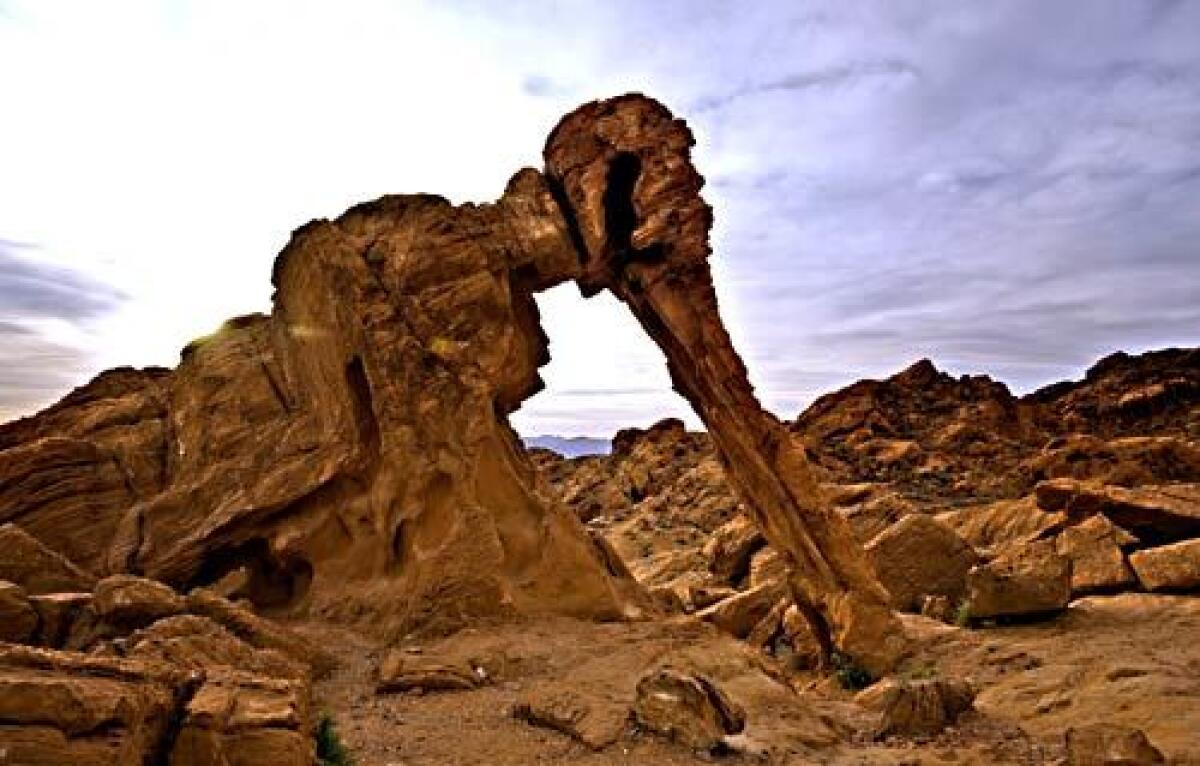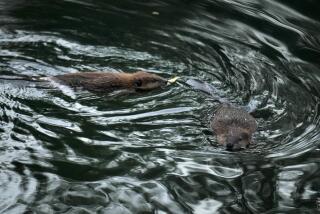Nevada: The landscape burns bright in the Valley of Fire

Every so often I experience a genuine “oh my gosh” moment. In Africa, I rounded a bend and came face to face with a large male lion. In Wyoming, driving south from Yellowstone, I rounded a curve and saw the Tetons rising majestically from the valley floor. And, most recently, in Nevada, as I crested a hill on the drab road through the Muddy Mountains, I saw the Valley of Fire.
Sculpted, chiseled and twisted red rock formations more dramatic than most others I have seen dominated the park’s 35,000 acres. I felt as though I had been transported to another planet. In a sense, it was another planet; this is where Capt. James Kirk died in the motion picture “Star Trek: Generations.” So I beamed myself down so I could explore this alien surface more carefully.
Valley of Fire lies an hour’s drive (and a few light-years) northeast of Las Vegas. It was Nevada’s first state park, so designated in 1935. But its 75th birthday pales compared with the chronological pedigree of the oldest rock in the park: It’s about 600 million years old. Back in that day, deep water covered this region. Slowly, the sea withdrew, leaving a desert of enormous, swirling sand dunes. Wind and rain then carved these dunes into the Aztec sandstone formations that vary from deep red to almost pure white.
My partner, Gloria Cortes, and I arrived in early April as spring was pushing winter aside in the Valley of Fire. Desert wildflowers were starting to bloom, and although sweeping fields of flowers are not as common as they are at higher, wetter elevations, I found a host of plant life, including barrel, beavertail and prickly pear cactus, phacelia, Indian paintbrush, sage, datura (highly toxic), brittlebush, indigo bush, dune primrose, four o’clocks, paper flowers, acacia and yucca.
This area is known for desert bighorn sheep, Nevada’s state animal. We were lucky to spot an impressively horned male, which shared his space with us for a bit — at one point, he was as close as 15 or 20 feet — before he disappeared into the rocks. You might also see ground squirrels, rabbits, antelope, coyotes, wild burros, lizards, chuckwallas, Gila monsters and, of course, rattlesnakes (pay attention to where you walk) and a plethora of birds.
But the scenery is the big draw in the Valley of Fire, which acquired its name, or so the story goes, this way: Well before the park was a park, an employee of the American Automobile Assn. was driving along a road, and as the sun set, the fading rays illuminated the red rock formations. He said it looked as though the entire valley was ablaze.
“When the shadows hit the bottom of the rock, the red color really stands out,” said Jim Hammons, the park’s chief ranger and a 22-year veteran of the valley. He likes the solitude too. “I live on site,” he said. “I’m away from the noise and traffic. ...This is my backyard, and I don’t have to mow it.”
The nearest town is Overton, 15 miles from the park’s east entrance. There is no lodging inside the park, only campsites, but that was fine with us because we enjoy camping. Both campsites are near the park’s west entrance, easily reached by a marked turnoff from Interstate 15. The larger and busier campground is Atlatl Rock Campground, which boasts hot showers and modern restrooms. RV’ers like it because it has water and power hookups.
Nearby is the smaller and more primitive Arch Rock Campground, where we decided to pitch our tent. It is more scenic and includes such notable rock formations as Arch, Piano and Poodle rocks, which look more or less like their names.
Although some of the campsites are secluded, even they offer only limited protection from the occasional desert winds. On our last night in the park, the winds whipped through the campground as though spun off from a hurricane. Our sturdy tent protected us, but the campers across the way were not as lucky: Their tent was virtually demolished. Come prepared for possible extra adventure.
Not surprisingly, Valley of Fire is a popular place for shooting movies and TV shows and for still photography. You can still see some structural remains of a Mexican hacienda from the 1966 movie “The Professionals,” starring Burt Lancaster and Lee Marvin. (This is marked on the park’s White Domes map.)
The biggest activity, however, may be car commercials. The White Domes area on the north side of the park where the road dead ends includes 31/2 miles of winding blacktop road with dramatic curves that make cars and commercials a visual love match.
Long before the auto was even a dream, various people began making their home here. Some experts think the first arrivals appeared more than 15,000 years ago. Back then, water flowed in the creeks, and plant and animal life was plentiful. The Anasazi arrived perhaps 1,000 years ago and may have been responsible for many of the rock art petroglyphs in the park, which include images of hunters, bighorn sheep and other less identifiable shapes. The most notable examples are on Atlatl Rock, where they are protected by panels of clear, Plexiglas-like panels and can be reached easily by climbing an iron stairway to a viewing platform.
But the scenery and the light take center stage. “The light can change, and then two hours later it all will look different again,” says Sandy Hufford, who has spent 21/2 years working in the park as a seasonal ranger and now as a full-time administrative assistant. “You see all these different shadows, colors and shapes. I still haven’t seen some of them two times in a row. I never get tired of coming to work.”
The names of the formations are almost as colorful: Duck Rock, Rainbow Vista, Elephant Rock, the Beehives, the Seven Sisters and Mouse’s Tank, which has its own colorful story. In the 1890s, lawmen were pursuing a Paiute Indian named Mouse. He escaped by hiding in one of the valley’s more rugged sections, where he found reliable drinking water in a natural basin, called a tank, that collected rainfall. In 1897, a posse cornered Mouse and killed him. It is an easy half-mile walk down the canyon to the tank, and you can see numerous petroglyphs on the surrounding rock walls.
In fact, you can see most of the Valley of Fire on foot, although you can see much of it by car too. Our stay of a few days wasn’t nearly long enough. I called my brother to tell him about our discovery and suggested he and his wife join us here next spring. He must have liked what he heard. It’s on the family vacation calendar.
More to Read
Sign up for The Wild
We’ll help you find the best places to hike, bike and run, as well as the perfect silent spots for meditation and yoga.
You may occasionally receive promotional content from the Los Angeles Times.






